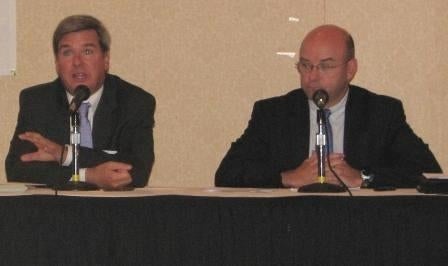MetroWest Infrastructure To Get State Attention
 PHOTO/BRANDON BUTLER
Gregory Bialecki, secretary of the state Executive Office of Housing and Economic Development, is joined by Jeffrey Mullan, secretary of the state Department of Transportation, to announce plans for the 495/MetroWest Development Compact.
PHOTO/BRANDON BUTLER
Gregory Bialecki, secretary of the state Executive Office of Housing and Economic Development, is joined by Jeffrey Mullan, secretary of the state Department of Transportation, to announce plans for the 495/MetroWest Development Compact.
While wastewater and roadway projects may not grab headlines, MetroWest advocates say infrastructure issues like those are key to the future success of not only the region, but the state as a whole.
That's why officials were happy to hear about the creation of a 495/MetroWest Development Compact from Gregory Bialecki, secretary of the state Executive Office of Housing and Economic Development, at last week's annual meeting of the 495/MetroWest Partnership. Bialecki was joined by Jeffrey Mullan, secretary of the state Department of Transporation, to make the announcement.
Bialecki said he wants to change what he sees as the state's "systematic under investment" in public infrastructure projects in MetroWest. The first step in the new committment is a one-year study that will determine and prioritize the infrastructure needs in the region.
"Instead of a laundry list, these issues need to be put in the context of a strategic plan," Bialecki said. "We're going to make sure public infrastructure is not the brake on growth in this region."
Preaching To The Choir
It was welcome news for regional advocates.
"I'm absolutely thrilled," said State Sen. Karen Spilka, D-Ashland. "This is exactly what we've been fighting for the last few years, which is a way to show that the MetroWest and 495 region is an economic engine for our state. This gives us recognition of that, and the recognition and the resources go hand in hand."
Bialecki said after the meeting that no new funding sources will be available for the region because of the compact, but the one-year study will provide a prioritized list of projects in the region that are of the highest importance.
"It's about using the existing funds more strategically," he said.
So, what are the top priorities in Metrowest?
One of the biggest is always transportation. For years regional officials have been fighting for improvements to be made to the intersection of Interstates 495 and 290, which includes a hairpin turn.
Further south on 495, the intersection of Route 9 with the highway has also been a point of concern for regional officials.
And while work is moving forward to improve commuter rail service through Boxborough, Littleton and Ayer, officials hope to expand train service to Framingham and Worcester in the coming years.
Having state officials aid in developing the priorities for the region, Matthews said, shifts the dynamics of the discussion.
Instead of regional advocates pushing for a project to be done, there will be a statewide, factually-based analysis of the merits of a project.
"This is really going to give us the type of comprehensive analysis and strategy that we will need in order to address some of the most outstanding and pressing needs," he said.
Matthews said he hopes to "maximize public input" in the process, but he said details of how the study will be completed are still being worked on.
Another major issue, Matthews said, is water and wastewater infrastructure. Investments by the state in improving those utilities have proven to yield significant private sector investment, Matthews said.
For example, in Framingham, a $7 million improvement to wastewater lines led to a $300 million investment by Genzyme, including construction of new manufacturing and office spaces. Similar infrastructure investments have led to business expansion in Hopkinton (Lonza Biologics) and Natick (The MathWorks).









0 Comments